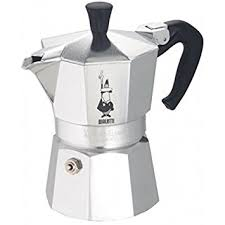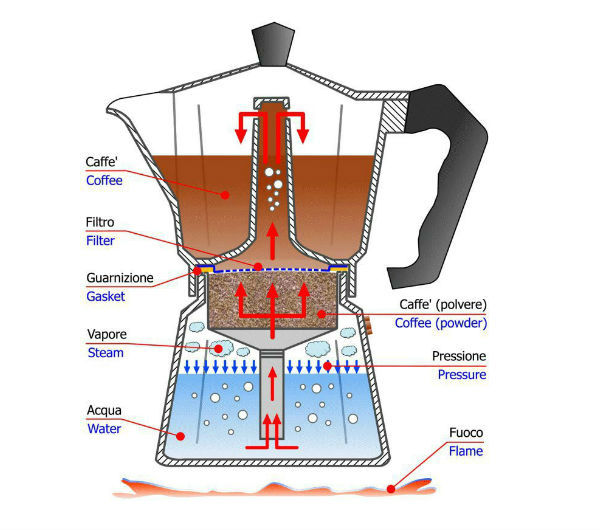 Last updated : February 2021.
Last updated : February 2021.
One thing I can freely say about the fresh coffee brewing world, particularly when it comes to brewing using the traditional Bialetti 6-Cup Stovetop Espresso Maker is that it isn’t for the faint hearted.
The entire process needs your utmost attention from start to finish as you will have to monitor the units brewing process and make sure that the heat setting does not exceed what the unit requires. Nonetheless, the quality of the coffee your Bialetti 6-Cup Stovetop Espresso Maker will produce will quickly make you forget the somewhat tedious nature of the unit’s brew process.That being said, and after receiving several questions relating to Bialetti coffee maker instructions, I felt seriously compelled to create an instructional brewing guide for the unit.
To make the instructions crystal clear and ensure that you do not encounter any brewing difficulties, I also thought it would be best to first include some of the most common Bialetti Moka Pot brewing issues, and how you can expertly evade them and brew cups of espresso that would shame expert Italian baristas hands down!
Bialetti Coffee Maker Instructions: Brewing Issues to look out for (and how to troubleshoot them!)
Contents
The two problems you will most likely encounter will relate to brew quality, that is, a) the resulting brew is either too strong or too weak or b) the brew has a metallic taste to it. Although these two issues are quite common, the good news is that they are both easy to tackle since they are both brought on by user-error.
Issue A -Your Brew is too weak/ too strong
This problem typically arises from using disproportionate amounts of water or coffee grinds. Too much water or too little coffee grinds results in a weak brew whereas less water and too much coffee grinds results in a very strong brew.
To make sure that you do not encounter this problem you can either a) stick to the measurement indicator markings or b) use the general brewing measurements which state that 8 ounces of water requires a tablespoon of coffee grinds.
Issue B -Your Brew has a Metallic Taste
This issue is typically a result of using a brand new Bialetti 6-Cup Stovetop Espresso Maker which needs to be “cured” or “seasoned” with essential coffee oils. In essence, the pot’s inside is all too fresh because it has never been used before. Naturally, the resulting brew will have a metallic taste to it since the fresh brew will come into direct contact with the “fresh” metal.
To make sure you do not encounter this problem, I recommend that you first cure your unit. To do this, purchase a pack of cheap coffee grinds (trust me, you don’t want to waste your favourite, high-quality coffee grinds to perform my home-made remedy for this). Use these grinds to brew several pots of java (around 4-5 complete brewing cycles).
You can opt to pour all of the resulting brew down the drain since it obviously won’t taste great (especially is you consider the facts that the quality of grinds you have used in the process is of low quality and that there is an already existing problem of having an extremely new Moka pot with a “fresh” metallic interior). What this curing process does is coat the metallic surfaces inside the unit’s pot with essential coffee oils which act as seasoning for a fresh brew. All in all, the chances of having metallic tasting brews are adequately eliminated.
Now that you have all this information at hand, it is time to get brewing!
Bialetti Coffee Maker Instructions: How to Make Superb Espresso (a 4- Step, Idiot-Proof Brewing Guide)
Important Note to Remember!
Unlike electrically powered coffee makers which tend to have automated shut off features, brewing with the Bialetti Moka Pot requires a brewer to be vigilant in order to avoid instances where the unit boils dry.
This results in one UGLY Bialetti Stovetop Moka Pot (both inside and out!) and also ruins your chances of getting superb quality brews.
In addition, a unit that has boiled dry requires extreme scrubbing to rid it from the charred stains left over by the completely evaporated espresso remains. Of course, this also means that you will have to cure your unit once more after the thorough scrubbing/ cleaning process. Now, who wants that? Certainly not you!
Bialetti Coffee Maker Instructions with Tips and Tricks you won’t find in a User Manual!
Step 1- Unit Set Up
Fill the unit’s base with preheated water to the point just below the level of the unit’s safety valve. I highly recommend preheating the water in order to avoid the Moka pot getting too hot and “cooking” the coffee grinds (a situation which has been noted to produce cups of icky, metallic tasting java!).
You must be careful not to pour in too much water because the space between the coffee filter and the top of the water is what heats up to provide the pressure required to force the hot water up and through the coffee grinds. If you overfill the unit with water, the resulting brew will definitely have a burnt or bitter taste to it! So, be really careful when pouring in your water.

Next, insert the unit’s filter funnel (coffee basket) and thereafter, fill it with your preferred brand of coffee grinds.
You MUST NEVER press the coffee grinds in as this will make it harder for the hot water to seep through. Also, pressing the coffee grinds to become compact means that you have put in more coffee grinds than needed (naturally, the resulting brew will be quite bitter-tasting YUCK!) Lastly, screw the unit’s cover/ top section firmly (but not too tight) to the unit’s base. Be sure to leave the unit’s lid off in order to allow you to monitor the brewing process.
Now, you are ready for the next step!
Step 2- Commencing the Unit’s Brewing Process
Place the Moka pot on your preferred heat source and set it on a low heat setting. If you are using a gas stovetop, make sure the flames do not lick the sides of the Moka Pot as this really ruins its aesthetic appeal as high flames discolour the unit’s sides.
Step 3- Monitoring the Brewing Process
Once you notice that the brew has started its brewing process (this can be noted by the characteristic whooshing/ puffin sound), you will notice that a stream of espresso coffee coming up into the unit’s top storage chamber. Once this stream has achieved the colour of yellow honey, remove the unit from the heat source and close its lid.
Wrap the unit’s lower storage compartment with a chilled towel. Alternatively, you can run it under cold tap water. This stops the unit’s extraction process temporarily (and is yet another trick to ensure that the coffee brewed does not have a metallic taste to it) but allows the unit to slowly complete its brewing process. In essence, the main idea is to achieve a small amount of espresso that is both rich and concentrated.
Step 4-Enjoying your Fresh Brew
Once the unit has completed its “bubbling up motions” pour the highly concentrated espresso which has collected in the top storage compartment and pour into your favourite coffee mug/ carafe, depending on your preference. If you don’t like very rich espresso, you can opt to add some hot water in your coffee mug to dilute. Enjoy!
If you don’t own a Bialetti 6-Cup Stovetop Espresso Maker and you’re interested in buying one, click here to purchase it from Amazon.com. You won’t regret it!